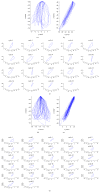A New Tridimensional Insight into Geometric and Kinematic Characteristics of Masticatory Cycles in Participants with Normal Occlusion
- PMID: 30255093
- PMCID: PMC6140131
- DOI: 10.1155/2018/2527463
A New Tridimensional Insight into Geometric and Kinematic Characteristics of Masticatory Cycles in Participants with Normal Occlusion
Abstract
The aim of this study was to analyze the general, geometric, and kinematic characteristics of the masticatory cycle's movements in a tridimensional way, using a method developed by our study group to provide a new insight into the analysis of mandibular movements due to advancement in the potential of computational analysis. Ten individuals (20.1 ± 2.69 years), molar class I, without mandibular movement problems participated in this study. The movements of the masticatory cycles, frontal and sagittal mandibular border movements, were recorded using 3D electromagnetic articulography and processed with computational scripts developed by our research group. The number of chewing cycles, frequency (cycles/s), chewing cycle areas/mandibular border movements areas ratios, and the mouth opening and closing speeds on the 3D trajectory of the chewing cycle were compared. The cycles were divided and analyzed in thirds. The masticatory cycles showed high variation among the individuals (21.6 ± 9.4 cycles); the frequency (1.46 ± 0.21 cycles/s) revealed a moderate positive correlation (R = 0.52) with the number of cycles. The frontal area ratios between the cycle area and the mandibular border movement presented higher values in the first third (6.65%) of the masticatory cycles, and the ratios of sagittal areas were higher and more variable (first, 7.67%; second, 8.06%; and third, 10.04%) than the frontal view. The opening and closing mouth speeds were greater in the second third of the masticatory cycles (OS, 57.82 mm/s; CS, 58.34 mm/s) without a significant difference between the opening and closing movements when the same thirds were evaluated. Further studies are necessary to improve the understanding of the masticatory cycles regarding the standardization of parameters and their values.
Figures


Similar articles
-
Systematic Standardized and Individualized Assessment of Masticatory Cycles Using Electromagnetic 3D Articulography and Computer Scripts.Biomed Res Int. 2017;2017:7134389. doi: 10.1155/2017/7134389. Epub 2017 Sep 18. Biomed Res Int. 2017. PMID: 29075647 Free PMC article.
-
Mandibular border movements: The two envelopes of motion.J Oral Rehabil. 2021 Apr;48(4):384-391. doi: 10.1111/joor.13124. Epub 2020 Nov 20. J Oral Rehabil. 2021. PMID: 33151578
-
Video tracking-based mandibular movement kinematic analysis in patients with nasopharyngeal carcinoma.Eur J Med Res. 2025 Jun 5;30(1):456. doi: 10.1186/s40001-025-02715-z. Eur J Med Res. 2025. PMID: 40474310 Free PMC article.
-
Kinematic Modeling of Normal Voluntary Mandibular Opening and Closing Velocity-Initial Study.J Prosthodont. 2015 Jun;24(4):279-86. doi: 10.1111/jopr.12212. Epub 2014 Sep 14. J Prosthodont. 2015. PMID: 25219889
-
Modulation of the masticatory path at the mandibular first molar throughout the masticatory sequence of a hard gummy jelly in normal occlusion.Cranio. 2015 Oct;33(4):263-70. doi: 10.1080/08869634.2015.1097275. Epub 2015 Dec 29. Cranio. 2015. PMID: 26715027
Cited by
-
Comparison of Increase in Masticatory Efficiency Between Removable Partial Dentures Retained With Clasps and Retained With Attachments.Clin Exp Dent Res. 2025 Apr;11(2):e70130. doi: 10.1002/cre2.70130. Clin Exp Dent Res. 2025. PMID: 40260841 Free PMC article.
-
Condylar Parameters and Mandibular Movement Patterns in Bruxers Using an Optical Jaw Tracking System.J Clin Med. 2024 Dec 19;13(24):7761. doi: 10.3390/jcm13247761. J Clin Med. 2024. PMID: 39768684 Free PMC article.
-
Accuracy and Reliability of AG501 Articulograph for Mandibular Movement Analysis: A Quantitative Descriptive Study.Sensors (Basel). 2020 Nov 6;20(21):6324. doi: 10.3390/s20216324. Sensors (Basel). 2020. PMID: 33171901 Free PMC article.
-
Influence of Framework Material and Abutment Configuration on Fatigue Performance in Dental Implant Systems: A Finite Element Analysis.Medicina (Kaunas). 2024 Sep 6;60(9):1463. doi: 10.3390/medicina60091463. Medicina (Kaunas). 2024. PMID: 39336504 Free PMC article.
-
Biomechanical Modelling for Tooth Survival Studies: Mechanical Properties, Loads and Boundary Conditions-A Narrative Review.Materials (Basel). 2022 Nov 7;15(21):7852. doi: 10.3390/ma15217852. Materials (Basel). 2022. PMID: 36363451 Free PMC article. Review.
References
MeSH terms
LinkOut - more resources
Full Text Sources
Other Literature Sources

